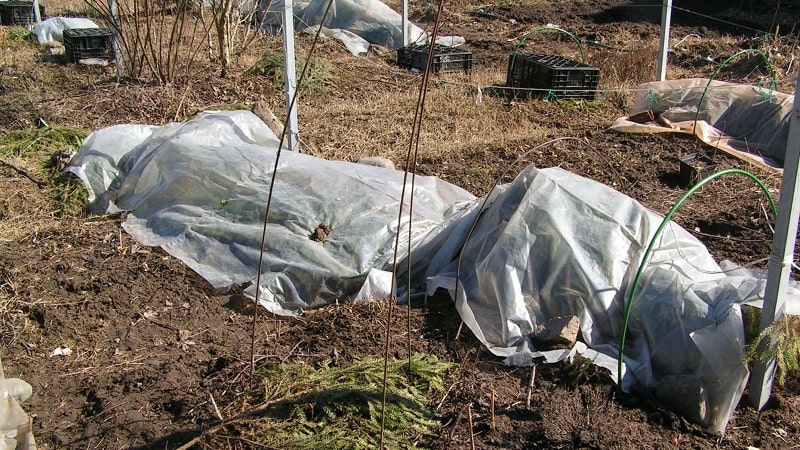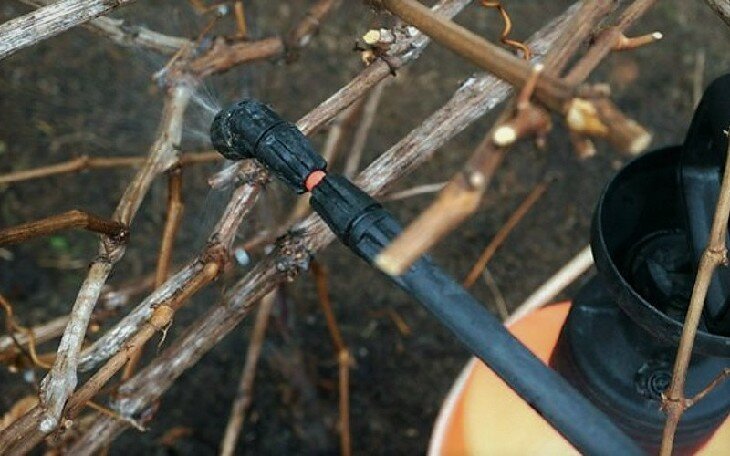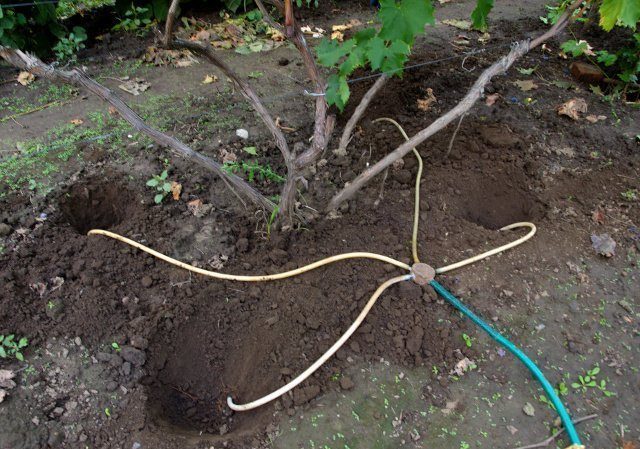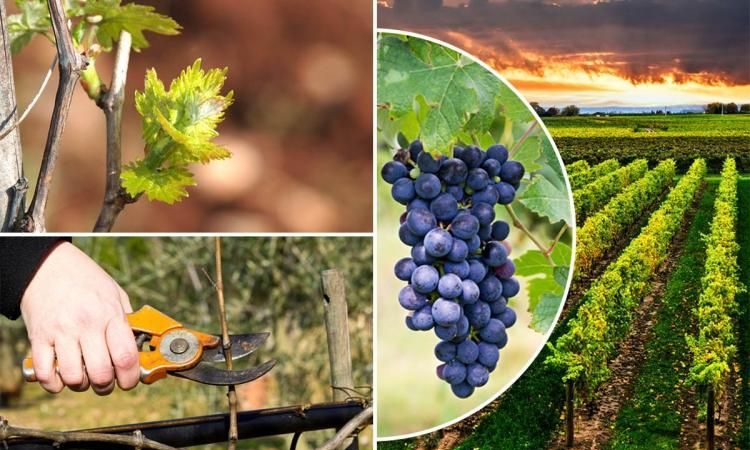Guide to caring for grapes in spring after opening
Today grapes are grown all over Russia - in the Urals and Siberia, in the Moscow and Volga regions, Krasnodar Territory and Kuban. The success of the future harvest largely depends on caring for the plant in the spring - it is during this period that such important procedures as removing the shelter, pruning and shaping the bush, the first watering and feeding take place.
We will tell you in detail how experienced growers carry out spring work and how to care for the plant so that there is a good harvest.
The content of the article
Features of spring grape care
So that the vineyard does not get sick and consistently produces tasty and juicy berries, grooming procedures begin at the end of March. These include:
- removal of the shelter;
- treatment with a solution of copper sulfate;
- pruning;
- formation;
- garter;
- protection against diseases and pests;
- watering;
- fertilization.
How and when to open grapes

The grapes are opened when the air temperature warms up to + 5 ° C and the snow melts. Grapes do not tolerate frost well, therefore it is not recommended to open it earlier than April. In the southern regions this is done on April 1-10, in the northern ones - at the end of the month, in the middle lane - in the middle. Climate characteristics are taken into account in each region.
Gardeners remove the protection gradually - a week before full opening, they ventilate the vine for 2-3 hours every day. To keep the stems healthy, do not delay the opening until May, otherwise the vines will become weak, and due to the prolonged lack of sunlight, metabolic processes will be disrupted and the plant will slow down in development. It is important to remember that under cover during the warm season, grapes will melt, humidity rises. There is a danger of decay.
Immediately after the procedure, the grapes are treated with fungicides to get rid of dangerous fungi and microbes, and to prevent diseases... For processing, a solution of copper sulfate (1%) is used. In 10 liters of water, dilute 100 g of the drug, pour the solution into a spray bottle. Vines are sprayed before buds form, otherwise chemical burns are possible. A dry and warm day is chosen for processing.
Possible problems after winter
In early spring, the grapes are weakened, so problems may arise immediately after removing the cover... A common case is leaf drying. This happens due to a lack of nitrogen, especially if organic and mineral fertilizers were not applied under the plant in the fall. In this case, complex fertilizers are used in dry or liquid form. For example, "Chelatin" contains a complex of microelements, is used against drying leaves, the appearance of white or brown spots.
Another common problem is phosphorus starvation. With a lack of phosphorus, the root system slows down in development, the assimilation of trace elements becomes difficult, and underdeveloped inflorescences are formed. If you do not take action, the grapes will die in 2-3 years. It is easy to recognize phosphorus starvation - vague purple spots appear on the leaves, vines and cuttings. To eliminate the problem, the plant is fed with superphosphate, bone meal, ammophos.
Attention! Winegrowers are advised to regularly examine the plant for spots, damage, signs of disease. If you find a problem in time, it will take less time and effort to fix it.
Spring pruning

Spring pruning is needed for old and young plants. Its goal is the formation of healthy and fruitful vines... If the grapes are not pruned, the stems will grow in a chaotic manner, resulting in lower yields. By pruning, the plant grows to the sides and upward, while all its parts are fed. Prune the grapes until the buds swell. Old and diseased shoots are removed, 2-3 eyes are left in young ones. For healthy growth, it is enough to leave 2-4 old shoots, the rest will be occupied by new fruiting vines.
Remove shoots with a sharp garden pruner so that the cut is perfectly even. The diameter of the young vine must be at least 0.6 mm. The cutting direction is strictly at right angles. The procedure is carried out in warm and dry weather, so that the sections dry out and harden.
If, after pruning, the grapes "cry", then the gardener did not pay attention to the timing and removed the branches at a time when the juices began to move and the buds swelled. In this case, the plant weakens, individual shoots dry up, yield decreases and the taste of berries deteriorates. Therefore, it is not worth delaying the pruning.
Bush formation
The formation of a bush improves metabolic processes inside the plant, due to which the fruits grow large and juicy, the plant is less likely to get sick. Grapes are formed in the first 3-4 years of life.
There are three types of shoots:
- summer (young);
- biennial (fruits are formed on them);
- perennial (responsible for the supply of nutrients and ensures the ripening of the crop).
The procedure is started with the formation of "sleeves" - this is the main branch that continuously gives fruit-bearing shoots. Summer residents choose the longest vines, while others cut them completely. The remaining vines should have 8-9 buds.
The next year, fan molding is used - 5-6 branches are left on both sides of the root. The fan-shaped method allows you to make the plant stronger and more fruitful. Subsequently, two fruit-bearing vines are formed on each arm. Outwardly, this arrangement of branches resembles a fan.
Garter

Tie up the grapes after forming... The shoots are straightened and laid out on a trellis, where they are ventilated for 3-4 days. The trellis is a special mesh wall to support the plant, or a simple structure of two columns and a wire stretched between them.
It is important to pay attention to the fact that the shoots should not be fixed on vertical supports. A soft wire is used for the garter. After 2-3 weeks, as the buds begin to grow, young shoots are tied to a higher level.
Treatment against diseases and pests

Grape prophylaxis begins at the end of April or beginning of May. In addition to the first treatment with a solution of copper sulfate, spraying with the drug "Quadris" is used. It protects against mildew and powdery mildew - common crop diseases that occur due to improper care, waterlogging, lack of vitamins and trace elements.
If "Quadris" is not at hand, use a solution of Bordeaux liquid. Leaves and vines are processed in the morning or evening, when there is no sun. The interval between sprays is 2-3 weeks.
In addition to diseases, pests also attack grapes - spider mites, grape aphids, leaf rollers, bears. Treatments with Actellik help protect against them. To prepare the solution, two ampoules of the product and 2 liters of water are required. Consumption rates - 2-3 liters per bush. Processing is carried out in personal protective equipment (glasses, suit, gloves, respirator).
Attention! If the plant is sick, use strong drugs, such as "Tiovit Jet". It inhibits the development of pathogens and is ideal for both open ground and greenhouses. At the same time, the drug does not suppress further plant development.
Watering

In the spring, water-charging irrigation is carried out, the purpose of which is to saturate the soil with moisture and keep it inside for as long as possible... Warm water is used for irrigation, it stimulates the growth and development of the vine. Cold water is not used, as it delays bud opening.
Water the grapes in a trench or hole dug at a distance of 20-30 cm from the bush. One plant has 2-3 holes arranged in a circle. 1-2 buckets of water are poured into each. After the hole, sprinkle with earth and mulch. Fertilizers are applied once or twice in the spring along with such irrigation. In the first year of life, the grapes are watered once a week in the evening. One plant takes about 20 liters of water.
Subsequently, the plant is watered using an underground method. The pipe is placed underground at a depth of 1 m, pre-drilled along the entire length of the hole. So water is consumed more economically and goes directly to the roots of the grapes. Also, underground watering increases resistance to frost and strengthens the immune system.
Top dressing

Grapes are fed from the second year of life. Manure, bird droppings, compost, biohumus are used from organic matter. They saturate the soil with nitrogen and stimulate the fruit set. From minerals, multicomponent fertilizers are chosen, based on phosphorus, potassium, nitrogen.
Summer residents use double superphosphate, urea, ammonium nitrate, bone meal. In order for all the nutrients to get to the roots, a groove 40 cm deep is pulled out around the plant. feeding twice in the spring - the first after pruning, the second after 3-4 weeks.
The following mixtures are used for feeding:
- 40 g of superphosphate, 20 g of ammonium nitrate, 10 g of potassium salt;
- 10 l of water, 5 g of boric acid;
- 10 l of water, 70 g of nitrophosphate;
- 5 l of water, 40 g of superphosphate, 80 g of urea.
Features of spring care in different regions
In regions with hot summers, attention is paid to watering. Drying out of grapes must not be allowed, at the same time, waterlogging is also unacceptable.... When watering, they are guided by weather conditions. If the summer is dry and hot, then water the grapes at least once a week. If it rains periodically, then the amount of watering is reduced. It is important to remember that waterlogging leads to the formation of diseases and the appearance of insect pests.
In regions with short and cool summers, the emphasis is on complex feeding. Grapes are a thermophilic plant and will often get sick with a lack of sunlight and heat. A balanced diet will help fill the deficit. It is also recommended to periodically carry out foliar feeding - this is the prevention of diseases.
Read also:
Kesha grape hybrid - description and characteristics
Tips from experienced winegrowers

Experienced growers share useful tips and tricks to keep the grapes growing tasty and juicy. cultivation:
- for irrigation, use settled water or water heated in the sun;
- do not water the trunk and leaves;
- to strengthen the immune system use complex mixtures - "Kemira" and "Florovit";
- before flowering, the soil is fertilized with a solution of boric acid;
- chlorine-containing fertilizers are not used for feeding;
- fertilize the pits, and do not scatter it on the ground;
- calculate the amount of trace elements so as not to overfeed the grapes.
Conclusion
Taking care of grapes in spring will not be a hassle if novice gardeners know and follow simple rules. They remove the shelter only after the air warms up and the snow melts. Then they carry out pruning and shaping - old and dry shoots are removed to create conditions for the growth of new fruiting vines. With the arrival of spring, the plants must be sprayed with a solution of copper sulfate or Bordeaux liquid.
For irrigation, use settled water, make sure that it does not fall on the leaves and trunk. And to stimulate fruiting, grapes are fed with manure, compost, urea, superphosphate.